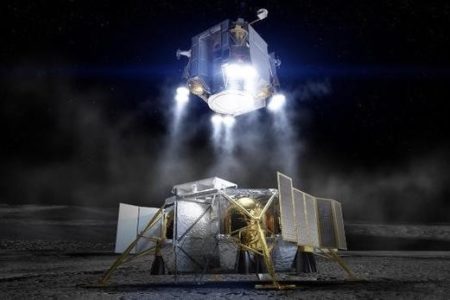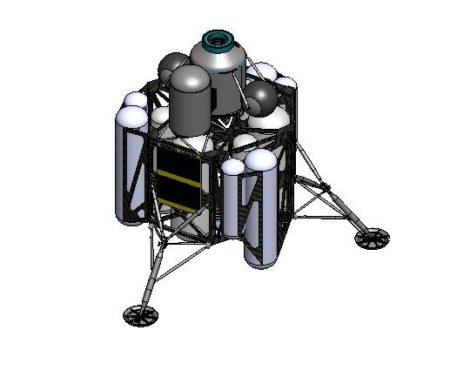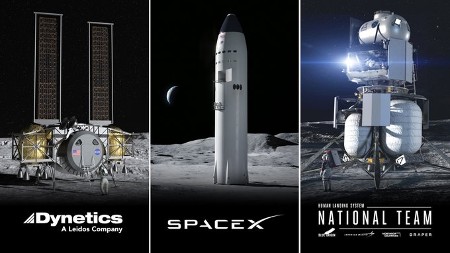May 4, 2020 – If you were a betting person a year ago would you have put your money on Boeing to be one of the prime contractors for the American space program’s return to the Moon? I think most would have said yes. After all, the Space Launch System (SLS), the rocket to replace the Saturn V is a Boeing project. But Boeing continues to underperform whether it is the building of its commercial aircraft, to the Starliner crew capsule, and SLS which is years behind in production and significantly over budget. Something has gone wrong in the corporate culture of Boeing, a complacency and sense of privilege that is wrecking the company’s performance and reputation.
Maybe that is a partial explanation for the April 30, 2020 announcement by NASA in its selecting of the design and development of the lunar lander for Artemis. The three companies selected included:
- Blue Origin, Jeff Bezos’ space company, with its proposed Integrated Lander Vehicle (ILV) that would be carried on Blue Origin’s New Glenn or United Launch Alliance’s Vulcan rocket.
- Dynetics, a company that has been working on environmental systems for the space agency, with its Dynetics Human Landing System (DHLS), a single descent and ascent lander that would also use the Vulcan rocket.
- SpaceX, with its Starship, a fully integrated and reusable spaceship for transit, descent, ascent and return which would be launched by the company’s Super Heavy reusable rocket.
The funding for this stage of the Artemis program will cover the costs for all three companies to further develop their concepts for review by the end of February 2021, less than 10 months from now.
NASA during the Apollo Program used private contractors to build the many components that made up the missions to the Moon fifty years ago. Working with commercial partners, therefore, is not new. But with Artemis, the reliance on the commercial sector appears to be far greater since two of these three companies, Blue Origin and SpaceX, have been developing fully-integrated launch and component sub-systems for space exploration on their own.
The following is a closer look at what NASA is actually funding.
Blue Origin
The Jeff Bezos’ project is known as the National Team and includes three commercial partners: Lockheed Martin, Northrop Grumman, and Draper. The ILV will be powered by Blue Origin’s BE-7 rocket engines. Lockheed will build the ascent system and crew cabin. Northrop will build the transfer component based on the Cygnus cargo ship that has been used to deliver payloads to the International Space Station (ISS). Draper will build the navigation, guidance, and control systems which have been its strength in its past work with NASA.
Dynetics
The DHLS will be a product produced by 25 different commercial partners headed up by Dynetics with support from its wholly-owned parent, Leidos, a company that claims more than 60 years of experience in serving NASA and space industry along with business in both the defense and intelligence arenas for the United States. DHLS will be a single integrated descent and ascent module with multiple refuelable engines designed for different purposes throughout the lunar mission. DHLS describes its solution as launch vehicle agnostic, adaptable to a number of rocket systems. Leidos has a long history with ISS and lunar missions having process and packaged 87 different payloads for NASA. The company’s strength is in human factors engineering, critical to ensure reliable habitability for Artemis in all facets of its execution.
SpaceX
By far the most radical departure from NASA’s past is the Starship designed to be fully reusable, and capable of traveling from the Earth to the Moon and back, as well as to other space destinations including Mars. The Starship is powered by SpaceX’s Raptor engines, and will use its expertise learned from the successful Falcon and Dragon programs. Falcon and Dragon have delivered 19 payloads to the ISS. Both the rocket and the Dragon capsule have been reused. Starship will have the same reusability factor in its design. It can be refueled in flight using Starship tankers parked in Earth orbit. The Super Heavy rocket will launch Starship from Earth and is fully reusable as well.
So what happened to the Boeing submission?
In November of last year, Boeing proposed an integrated Human Lander System (HLS) designed to descend from lunar orbit to the surface and ascend back to orbit later as a single unit. The HLS would be launched by the SLS Block 1B rocket and would use the proven technology of the Boeing CST-100 Starliner developed for ferrying human crews from Earth to the ISS. Consider that SLS remains a giant boondoggle and money pit, and the Starliner’s test mission failed to rendezvous and dock with the ISS, requiring a second try in the next few months, ascribing the word “proven” to Boeing’s proposal is suspect.

Who else submitted a proposal to Boeing?
Vivace, a San Antonio, Texas-based company was one of the initial five submitting proposals to NASA for Artemis. Vivace builds guided missiles and spacecraft. The company has an ongoing NASA relationship doing systems engineering for ISS, as well as work on the commercial human and material transportation components in support of the station. Although I looked for more information on the company’s submission, the only thing I could find was a Lunar Lander Study illustration seen below.

Will NASA have the option to use more than one of these submissions?
Is NASA limited to picking only one solution from these three finalists? Probably yes. In the initial acquisition strategy, the agency had described up to four prime contractors with finalists providing crewed demonstration missions. But this is unlikely for the final three. The decision on one will come next spring or early summer.
In the meantime, here is a summary of the merits of the final three.
- Blue Origin’s submission was given the most money, $579 million. Rated as technically acceptable with a very good management score, the assessment noted there were benefits of working with the company and its partners beyond the initial 2024 first mission. It noted, however, potential weaknesses in terms of power and propulsion systems largely because what was being proposed had yet to be fully designed and tested. The evaluation pointed out that the company had submitted aggressive timelines and milestones with no demonstration to-date that it could accelerate development at the prescribed pace.
- Dynetics received $253 million. Rated as very good both technically and for its management with the submission exceeding NASA requirements for 2024. The low-slung architecture of its lander was seen as one its most attractive aspects not only for crew safety, but also for visual flight controls and safety. Two iterations of its design allow for crewed and uncrewed operation. NASA concluded the design, development, and testing of the lander would meaningfully reduce the time to build it. The only issue of weakness was seen in the propulsion and power systems because of the proposed complexity and the development timelines needed to meet NASA’s 2024 target date.
- Then there is the maverick in the bunch, SpaceX, which received $135 million. Rated as acceptable both technically and for management, SpaceX’s proposal was seen as exceeding all NASA performance requirements for a 2024 demonstration mission. With the Starship, it would provide mission flexibility for crew and scientific payload. With two fully redundant airlocks, the Starship would make egress and re-entry far less risky to crews. Also seen as an advantage, SpaceX’s experience in missions to-date. What was questioned was the scheduling of testing for the propulsion systems which SpaceX is currently planning to do with existing prototypes that it has been building at its Texas-based facility. Notable as well is the yet-to-be-built Super Heavy launch vehicle which for the moment remains a weakness of the proposal. But NASA’s evaluation also considered how quickly SpaceX is developing prototypes and following its aggressive timelines for a beyond low-Earth orbit demonstration flight scheduled for 2022 whether the company wins the lunar lander prime contract or not. So SpaceX is a done deal regardless of the NASA decision. SpaceX will have to overcome one of its historic challenges. Meeting self-proclaimed milestones has not been its strength for the Falcon9, Falcon Heavy, and Dragon. If it has learned its lessons from these past experiences it represents the least expensive option for Artemis.








